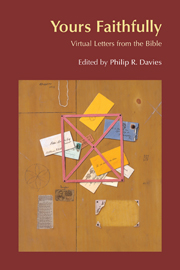Book contents
- Frontmatter
- Contents
- INTRODUCTION: IN PRAISE OF VIRTUAL LETTERS
- 1 Sarah to Abraham
- 2 Isaac to Abraham
- 3 Sarah to Rebekah
- 4 Pharaoh Ramses to Moses
- 5 Aaron to Miriam
- 6 Jephthah's Daughter to her Father
- 7 Samson to Delilah
- 8 Shmuel ben Elkanah to Achish
- 9 Absalom to David
- 10 Salu Father of Zimri to Zur Father of Cozbi
- 11 Ahitophel to Absalom
- 12 Ahitophel to Eliam, his Son
- 13 King Ahab to his Steward Obadiah
- 14 King Ahab to the Writers of the Books of Kings
- 15 Athaliah to Elijah the Tishbite
- 16 The Big Fish to Jonah
- 17 Nineveh to Judah
- 18 Jeremiah to Ezekiel
- 19 Between Zedekiah and Jeremiah
- 20 Haggai to Zechariah
- 21 Zechariah to Haggai
- 22 Esther to her Mother
- 23 John the Baptizer to Jesus
- 24 Jesus to his Mother
- 25 Judas Iscariot to James; James to his Family
- 26 From a Greek Woman of Tyre to Jairus of Galilee
- 27 Pilate's Wife to her Husband
- 28 Publius Philostratus to an Author
- 29 Onesimus to Paul
- 30 ‘Jezebel’ of Thyatira to John of Patmos
- 31 Letter to Bible Authors [Draft]
- List of Authors
INTRODUCTION: IN PRAISE OF VIRTUAL LETTERS
- Frontmatter
- Contents
- INTRODUCTION: IN PRAISE OF VIRTUAL LETTERS
- 1 Sarah to Abraham
- 2 Isaac to Abraham
- 3 Sarah to Rebekah
- 4 Pharaoh Ramses to Moses
- 5 Aaron to Miriam
- 6 Jephthah's Daughter to her Father
- 7 Samson to Delilah
- 8 Shmuel ben Elkanah to Achish
- 9 Absalom to David
- 10 Salu Father of Zimri to Zur Father of Cozbi
- 11 Ahitophel to Absalom
- 12 Ahitophel to Eliam, his Son
- 13 King Ahab to his Steward Obadiah
- 14 King Ahab to the Writers of the Books of Kings
- 15 Athaliah to Elijah the Tishbite
- 16 The Big Fish to Jonah
- 17 Nineveh to Judah
- 18 Jeremiah to Ezekiel
- 19 Between Zedekiah and Jeremiah
- 20 Haggai to Zechariah
- 21 Zechariah to Haggai
- 22 Esther to her Mother
- 23 John the Baptizer to Jesus
- 24 Jesus to his Mother
- 25 Judas Iscariot to James; James to his Family
- 26 From a Greek Woman of Tyre to Jairus of Galilee
- 27 Pilate's Wife to her Husband
- 28 Publius Philostratus to an Author
- 29 Onesimus to Paul
- 30 ‘Jezebel’ of Thyatira to John of Patmos
- 31 Letter to Bible Authors [Draft]
- List of Authors
Summary
The title ‘Yours Faithfully’ might be a rather misleading one for this collection. Just as ‘virtual’, which used to mean something like ‘virtuous’, ‘possessing effective power’, now means ‘artificial’, ‘synthetic’ or ersatz (as in ‘virtual reality’), so these ‘virtual letters’ are of course confections. They are certainly not always faithful to historical reality or plausibility, though some do indeed try to represent the implied views of their supposed writers, most of whom have not had the opportunity of expressing these before. Nor are they all ‘faith-ful’, expressing religious values that many readers of the Bible espouse (and perhaps impute to the biblical characters, or at least the virtuous ones). Some, on the contrary, are defiant, and some subversive. But all, I hope, worth reading.
What do we define as a ‘letter’? In his edition of ancient Hebrew letters, Dennis Pardee defines a letter as ‘a written document effecting communication between two or more persons who cannot communicate orally’ (Pardee 1982: 2), but this defines the genre, not the function of each and every letter. Ancient letters serve a variety of writers, addressees and communicative contexts. The letter is not, and never was, always a real communication between two living persons. There are collections of both ancient Mesopotamian and Egyptian model letters, provided for the training of scribes and, as Edward Wente says of the Egyptian examples (Wente 1990: 2), ‘it is not always easy to determine which of these letters are copies of real letters and which ones are entirely fictitious’.
- Type
- Chapter
- Information
- Yours FaithfullyVirtual Letters from the Bible, pp. vii - xiiPublisher: Acumen PublishingPrint publication year: 2004

